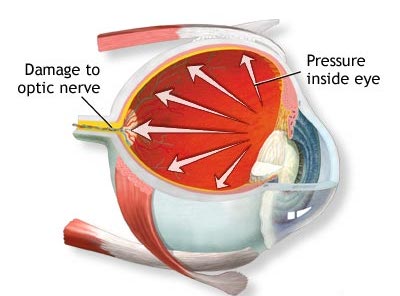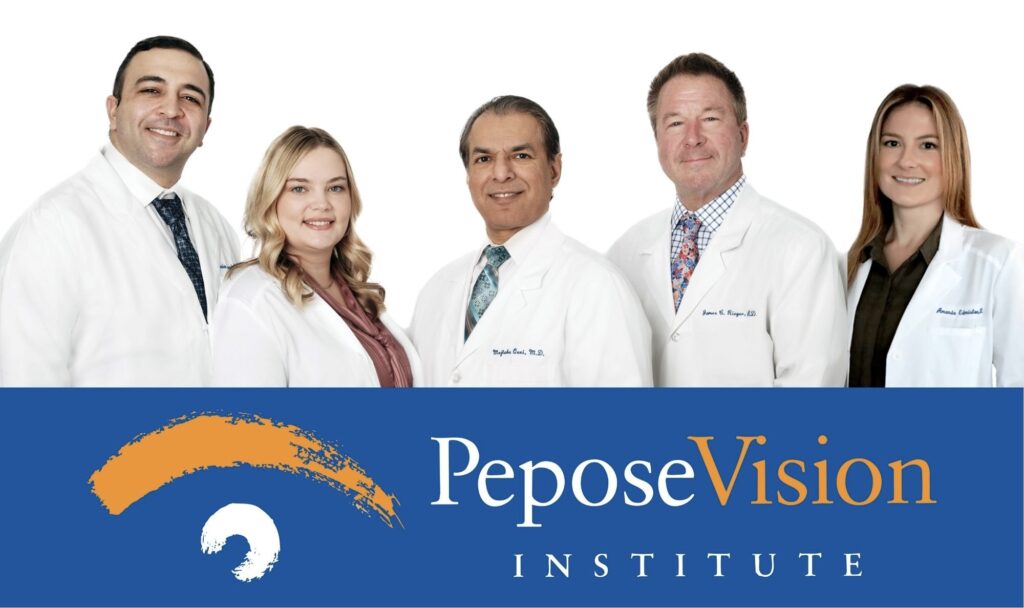Glaucoma Treatment
Glaucoma is a permanent loss of side vision caused by damage to the optic nerve. It is often caused by pressure buildup in the eye, but can also be triggered by other factors. The Glaucoma Research Foundation estimates that more than 3 million Americans have glaucoma, but only half of these people know they have it. Approximately 120,000 people go blind from glaucoma each year, accounting for 9-12 percent of all new cases of blindness in the United States.
Glaucoma is the second leading cause of blindness and the first leading cause of preventable blindness.
Pepose Vision is well-known as a leader in glaucoma diagnosis and management, both in the Bi-State region and the entire United States.

How do I know if I have glaucoma?
Glaucoma is a complicated disease in which damage to the optic nerve results in vision loss.
There are several forms of glaucoma; the two most common forms are primary open-angle glaucoma (POAG) and angle-closure glaucoma (ACG). Open-angle glaucoma is often called “the sneak thief of sight” because it has no symptoms until significant vision loss has occurred.
Symptoms of Open-Angle Glaucoma
There are typically no early warning signs or symptoms of open-angle glaucoma. It develops slowly and sometimes without noticeable sight loss for many years.
Most people who have open-angle glaucoma feel fine and do not notice a change in their vision at first because the initial loss of vision is of side or peripheral vision, and the visual acuity or sharpness of vision is maintained until late in the disease.
By the time a patient is aware of vision loss, the disease is usually quite advanced. Vision loss from glaucoma is not reversible with treatment, even with surgery.
Because open-angle glaucoma has few warning signs or symptoms before damage has occurred, it is important to see a doctor for regular eye examinations. If glaucoma is detected during an eye exam, your eye doctor can prescribe a preventative treatment to help protect your vision.
In open-angle glaucoma, the angle in your eye where the iris meets the cornea is as wide and open as it should be, but the eye’s drainage canals become clogged over time, causing an increase in internal eye pressure
and subsequent damage to the optic nerve. It is the most common type of glaucoma, affecting about four million Americans, many of whom do not know they have the disease.
You are at increased risk of glaucoma if your parents or siblings have the disease, if you are African-American or Latino, and possibly if you are diabetic or have cardiovascular disease. The risk of glaucoma also increases with age.
Symptoms of Angle-Closure Glaucoma
- Hazy or blurred vision
- The appearance of rainbow-colored circles around bright lights
- Severe eye and head pain
- Nausea or vomiting (accompanying severe eye pain)
- Sudden sight loss
Angle-closure glaucoma is caused by blocked drainage canals in the eye, resulting in a sudden rise in intraocular pressure. This is a much more rare form of glaucoma, which develops very quickly and demands immediate medical attention.
In contrast with open-angle glaucoma, symptoms of acute angle-closure glaucoma are very noticeable and damage occurs quickly. If you experience any of these symptoms, seek immediate care from an ophthalmologist.
We always provide our patients with compassionate and customized care.
How do you treat glaucoma?
Our goal in glaucoma treatment is to lower pressure in your eye (intraocular pressure). Pepose Vision utilizes the most advanced care available, including the SLT Laser treatments and Sight Sciences Visco™ 360. Your doctor will discuss the available treatments after a thorough examination.
Please understand … glaucoma can’t be cured, and damage caused by the disease can’t be reversed, but treatment and regular checkups can prevent vision loss in people with early glaucoma. If vision loss has already occurred, treatment can slow or prevent further vision loss.
The absolute latest glaucoma treatments

Visco360 is a surgical device. If we think of the drainage system for the intraocular fluid as a series of internal canals that eventually drain into the veins on the surface of the eye, one reason why the drain can become clogged is if the canals “collapse” and narrow. With Visco 360, a microcannula is used to gain entry into the drainage canal via a micro-incision. A thick fluid is injected into the drainage canal in order to inflate and force open the passageways.
This is a generally painless 5 to 15-minute procedure that can be performed at the same time or separately from cataract surgery. The advantage of Visco 360 is that it can be performed as a stand-alone procedure and does not have to be combined with cataract surgery (unlike iStent which does). Like other glaucoma microsurgeries, Visco 360 is a medical procedure performed in the operating room that is submitted to insurance for coverage and reimbursement.
Glaucoma FAQs
St. Louis Glaucoma Treatment Center
Did you know Pepose Vision is also an advanced research facility?
Why choose Pepose Vision for your glaucoma treatment?
Experience
Pepose Vision Institute is a leader in the use of the most advanced “cold laser” to lower pressure inside the eye. Because the vision damage from glaucoma cannot be reversed, the best approach is early detection and treatment. That’s why it’s important to know that Pepose Vision Institute is one of the nation’s leaders in developing the most precise tools to measure true eye pressure, and is the only bi-state provider to offer these advanced tests to its patients.
Testing
Each patient undergoes a 3 hour state-of-the-art testing process, directly supervised by our surgeons who then create a precise, personalized treatment plan.
Technology
PVI uses numerous diagnostic devices to assess the extent of glaucoma damage and to confirm each test result. We then collaborate with eye technology industry leaders on “next generation” diagnostics. We also offer on-site cold laser treatment which may reduce the need for lifelong use of eye drops and other medications.
Lifetime Commitment
Our surgeons monitor the progress of your eyes for the rest of your life to maintain the very best vision outcome possible.
We recommend that the best way to ensure a successful outcome in treating your glaucoma is to choose a highly experienced surgeon who is involved in developing state-of-the-art treatments to enhance your vision outcome.
Our State-Of-The-Art Technology
At Pepose Vision Institute, we invest in new, early detection glaucoma technologies because we believe sight is a precious gift and glaucoma is the most prevalent “silent thief” of vision among adults. We are one of the first in the nation to offer the latest diagnostic and surgical technologies to our glaucoma patients.
We’ve worked with some of the leading developers of eye technology to perfect state-of the-art diagnostic tests and treatments for glaucoma. These technologies, and our unparalleled experience in interpreting and
utilizing them, ensure that your procedure is tailored exactly to your needs.
To be sure that your glaucoma is managed in an optimal fashion, we recommend you select an eye care subspecialist who is integrally involved in developing glaucoma technology to maximize your vision outcome. Below are some of the technologies we use to diagnose and treat glaucoma:
Meet Your St. Louis Glaucoma Specialists

What is the glaucoma treatment process?
1) Schedule Your Diagnostic Exam at PVI
Call us today at 636-728-0111 or toll-free, 1-877-862-2020, or click here to contact us online to schedule your glaucoma diagnostic examination. We will evaluate your eyes using the most precise instruments available. If you have already been diagnosed with glaucoma, we will assess your intraocular pressure, and, if indicated, discuss laser alternatives, including SLT laser treatment. We guarantee that once you have completed our diagnostic exam, you’ll feel confident that we can help you minimize any potential threat to your vision. Be sure to bring someone to drive you home, since we’ll be dilating your eyes as part of the exam.
2) Schedule Your Laser Treatment
If your PVI surgeon believes that this is the safest, most effective method to preserve your sight, we’ll schedule your procedure. Your surgery scheduler will take care of pre-certification, if required by your insurance company. You will be given precise pre- and post- treatment instructions regarding your eye care and use of medications.
3) Arrive for Your Pain-Free Treatment in the Surgery Center in our Building
Each eye will be scheduled on a different day. Please bring a driver on the day of your laser procedure and allow 1 hour for this visit. Your surgeon will answer any questions you still may have about your eye condition or treatment. Your procedure will be totally painless, thanks to topical anesthesia. If you are currently using eye drops to control your glaucoma, you will continue to use them until your post-operative visit approximately 6 weeks later.
What’s your next step?
If you think you might have glaucoma, or any vision issues, please come see us.
Our experienced doctors will use advanced diagnostics to determine exactly how to best help you see your very best, patiently answer your questions and carefully explain all your options.

